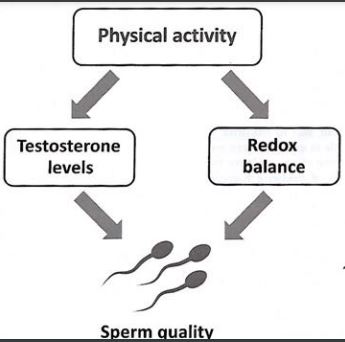Male fertility and physical activity
Male fertility is dependent upon a balance between testosterone levels and REDOX reactions, which define sperm quality. With regular exercise, anti oxidant stress becomes more regulated, which in turn is thought to impact the mitochondria.
The type of exercise appears to be important, as acute intense exhaustive exercise decreases male reproductive potential, whereas a combination of endurance and resistance training may be a successful therapy for male fertility. Exercise, in general has an impact on hypothalamic-pituitary gonadal axis. There are also 4 broad categories of spermatogenesis (spermatogonia, spermatocytes, spermatids, and spermatozoa) which all require different types of mitochondria as an intermediary. A parallel association between structural changes, cell localization and metabolic status during spermatogenesis has been postulated, where the number and size of mitochondria cristae is increased by an increase in respiratory activity. Furthermore, exercise stimulates testosterone which plays a major role gamete mitochondrial production in Leydig cell steroidogenesis.
Evidence
- moderate aerobic treadmill training improves semen quality in obese men (Rosety MA et al 2017 Nutr Hosp., 34, 3, 603-7)
- moderate intensity continuous training was more beneficial than high intensity continuous or high intensity interval training at both 12 and 24 weeks after training (Hajizadeh Maleki et al 2017 Reproduction, 153, 2, 157-74)
- 1026 sedentary men attending a fertility clinic were reported to have improved sperm quality with moderate aerobic exercise (Hajizadeh Maleki et al 2017, Cytokine, 2017, 92, 55- 67)
- training at higher intensities seems to diminish sperm quality especially amongst cyclists, mountain trekkers and runners (Hajizadeh Maleki et al 2017 Reproduction, 153, 2, 157-74 ; Hajizadeh Maleki et al 2015 Clin J Sport Med, 25, 6, 535-40; Hajizadeh Maleki et al 2014 Clin J Sport Med, 24, 4, 302-7; Vaamonde D et al 2006, Int J Sp Med, 27, 9, 680-9)
- in some cases it's the type of exercise which impacts sperm quality, such as the gonadal irritation from heat, tight clothes and mechanical loading during repetitive long distance cycling
Mechanisms
The common target of physical exercise affects, such as oxidative stress and testosterone are gamete mitochondria, as these control energy metabolism and oxidative homeostasis. Mitochondrial Leydig Cells must be functional to synthesise testosterone. Dysfunction results in oxidative damage to macromolecules (lipids, proteins, mtDNA) and cause a decrease in ATP levels. When proteins and membrane lipids are damaged and mtDNA is fragmented the process of oxidative phosphorylation is severely affected, causing a decrease in energy production, with subsequent meiotic arrest and abnormalities in sperm morphology. Additionally, high levels of reactive oxygen species (ROS) leads to the release of cytochrome c, which induces apoptosis and a decrease in sperm number.
Reference
Lunetti P, Capobianco L, Zara V, Ferramosca A (2021) Physical Activity and Male Reproductive Function : a new role for Gamete Mitochondria. Exercise and Sports Science Reviews, 42, 2, 99-106
Uploaded : 3 February 2022





